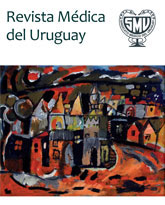Utilización de placas costales de titanio en la reconstrucción de grandes defectos de la pared torácica postresección de tumores
Resumen
La reconstrucción de grandes defectos de la pared torácica continúa siendo un tema controversial. Las complicaciones por este tipo de resecciones van de 46% a 69% con los antiguos materiales de osteosíntesis. La reciente incorporación del titanio, debido a que es inoxidable, químicamente inerte y que rápidamente se adapta a la forma de la pared torácica, lo hace un material ideal para este tipo de procedimientos. Se presenta el caso clínico de un paciente de 54 años, portador de enfermedad de Von Recklinghausen, en el que se realiza resección de un tumor de la cara anterolateral derecha del tórax, que incluye cuatro arcos costales y sus correspondientes cartílagos reconstruyéndose con placas de titanio y malla de Prolene. El paciente evolucionó favorablemente en el posoperatorio, sin complicaciones. Este tipo de sistemas de osteosíntesis con placas de titanio MatrixRib® brindan un material seguro y con buenos resultados tanto funcionales como cosméticos.
Citas
(2) Deschamps C, Tirnaksiz BM, Darbandi R, Trastek VF, Allen MS, Miller DL, et al. Early and long-term results of prosthetic chest wall reconstruction. J Thorac Cardiovasc Surg 1999; 117(3):588-91.
(3) Weyant MJ, Bains MS, Venkatraman E, Downey RJ, Park BJ, Flores RM, et al. Results of chest wall resection and reconstruction with and without rigid prosthesis. Ann Thorac Surg 2006; 81(1):279-85.
(4) Incarbone M, Pastorino U. Surgical treatment of chest wall tumors. World J Surg 2001; 25(2):218-30.
(5) Berthet JP, Canaud L, D’Annoville T, Alric P, Marty-Ane CH. Titanium plates and Dualmesh: a modern combination for reconstructing very large chest wall defects. Ann Thorac Surg 2011; 91(6):1709-16.
(6) Gonfiotti A, Santini PF, Campanacci D, Innocenti M, Ferrarello S, Caldarella A, et al. Malignant primary chest-wall tumours: techniques of reconstruction and survival. Eur J Cardiothorac Surg 2010; 38(1):39-45.
(7) Campbell RM Jr, Smith MD, Mayes TC, Mangos JA, Willey-Courand DB, Kose N, et al. The effect of opening wedge thoracostomy on thoracic insufficiency syndrome associated with fused ribs and congenital scoliosis. J Bone Joint Surg Am 2004; 86-A(8):1659-74. 7
(8) Lardinois D, Müller M, Furrer M, Banic A, Gugger M, Krueger T, et al. Functional assessment of chest wall integrity after methylmethacrylate reconstruction. Ann Thorac Surg 2000; 69(3):919-23.
(9) Coonar AS, Wihlm JM, Wells FC, Qureshi N. Intermediate outcome and dynamic computerised tomography after chest wall reconstruction with the STRATOS titanium rib bridge system: video demonstration of preserved bucket-handle rib motion. Interact Cardiovasc Thorac Surg 2011; 12(1):80-1.
(10) Gimferrer JM, Belda J, Catalán M, Callejas MA, Canalis E, Serra M. Experiencia en el tratamiento quirúrgico de los tumores primarios malignos de la pared torácica. Cir Esp 2003; 73(2):110-3.
(11) McCormack PM. Use of prosthetic materials in chest-wall reconstruction: assets and liabilities. Surg Clin North Am 1989; 69(5):965-76.
(12) Berthet JP, D’Annoville T, Canaud L, Marty-Ané CH. Use of the titanium vertical ribs osteosynthesis system for reconstruction of large posterolateral chest wall defect in lung cancer. Interact Cardiovasc Thorac Surg 2011; 13(2):223-5.
(13) Dang NC, Siegel SE, Phillips JD. Malignant chest wall tumors in children and young adults. J Pediatr Surg 1999; 34(12):1773-8.
(14) Mansour KA, Thourani VH, Losken A, Reeves JG, Miller JI Jr, Carlson GW, et al. Chest wall resections and reconstruction: a 25-year experience. Ann Thorac Surg 2002; 73(6):1720-5.
(15) Arnold PG, Pairolero PC. Chest-wall reconstruction: an account of 500 consecutive patients. Plast Reconstr Surg 1996; 98(5):804-10.
(16) Ducatman BS, Scheithauer BW. Malignant peripheral nerve sheath tumors with divergent differentiation. Cancer 1984; 54(6):1049-57.
(17) 17. Guo A, Liu A, Wei L, Song X. Malignant peripheral nerve sheath tumors: differentiation patterns and immunohistochemical features - a mini-review and our new findings. J Cancer 2012; 3:303-9.














